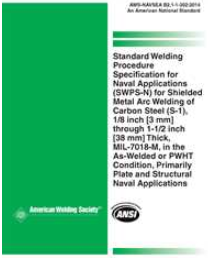A Standard Welding Procedure Specification (SWPS) is a welding procedure that must meet the rules for qualification of AWS B2.1 – Specification for Welding Procedure and Performance Qualification, and be approved by the AWS B2 Committee on Procedure and Performance Qualification. All SWPSs have supporting Procedure Qualification Records (PQRs) which comply with the rules set forth by AWS B2.1 and which also aim at complying with all of the major codes such D1.1, D1.2, D1.3, D1.6 Structural Welding Codes and ASME Boiler and Pressure Vessel Code.
SWPSs should not be confused with prequalified welding procedures as we explain on our previous post on How to Develop Welding Procedure Specifications. Prequalified welding procedures are exempt from testing and thus do not have supporting PQRs.
SWPSs are available for purchase from the American Welding Society. Each SWPS can be purchased at a price of $272 for non AWS members or for $204 for AWS members. That’s a significant amount of money for a welding procedure, especially if you are not sure exactly what you’ll get for you money. AWS publishes a “preview” for their SWPSs but this only consists of the first 8 pages of the document. These pages contain the cover page with a brief description. The rest of the pages on the preview are only committee members, an abstract and the list of supporting PQRs (numbers only).
So what do you actually get with the SWPS? One thing you do not get is a filled out WPS form. Rather, you get a long list of parameter ranges from which to choose. This is good because it provides flexibility – meaning you can use different diameter electrodes, can weld in different joint configurations and different welding positions.
SWPS will also provide instructions for items such as preheating, post weld heat treatment, interpass cleaning and when or if post weld heat treatment can be omitted. Below you can see how a SWPS is presented when you purchase it. The information below will be presented over several pages on the document.
Standard Welding Procedure Specification (SWPS)
LIMITATIONS
List relevant information such as a procedure not being qualified for notch toughness applications.
WELDING PROCESSES
Welding Process: List the welding process used
Method of Application: This will be either Manual, Semi-automatic or Automatic usually
BASE METALS
Base Metal: Identifies the base material group number and any other designations such as M or P numbers.
Thickness Range: Provides the range of thickness qualified
Pipe Diameter: If the procedure is for or applies to pipe it will provide the ranges of diameter qualified
FILLER METALS
Filler Metal Specification: AWS Specification such as A5.28 or ASME specification
Classification: AWS or other governing body classification such as ER70S-6 or E7018
Deposit Thickness Range: Details the range of thicknesses for weld deposit (for all passes) or range of fillet weld sizes.
Consumable Insert: Whether permitted or not and type of insert is used.
JOINT DESIGNS
Joint Designs: A list of allowable joints are provided with graphical representations
Backing: Whether permitted or not
Backing Material: Type and group of material
POSITIONS
Permitted Positions: Positions for which this SWPS is for
Vertical Progression: Uphill or downhill if vertical positions are permitted
PREHEAT AND INTERPASS TEMPERATURES
Preheat Temperature: Minimum and maximum temperature to which the part must be heated prior to welding.
Interpass Temperature: Minimum and maximum temperature at which the part must between welding passes.
Preheat Maintenance: Instructions pertaining to maintaining the interpass temperature
GAS
Shielding Gas: Shielding gas or mix of shielding gas to be used
Flow Rate: Flow rate range
POSTWELD HEAT TREATMENT
Postweld Heat Treatment: Temperature of PWHT
Exemption from PWHT: When PWHT is not mandatory
TECHNIQUE
Weave or Stringer Bead: Weave or stringer
Peening: Whether permitted or not
Initial Cleaning: What cleaning method or methods are allowed
Interpass Cleaning: Method of interpass cleaning
Back Gouging: Whether necessary or not
Single or Multipass: Whether the weld is single pass or multiple passes
Bead Thickness: Maximum thickness of a single weld bead
Repair: Instructions on how to carry out repairs
Pulsing Current: Parameters for pulsing current or whether it is not permitted
ELECTRICAL CHARACTERISTICS
Here is where the SWPS will provide the amperage and voltage for your procedures. It provides ranges for different diameter wires, for root and fill passes and for different positions. It will also distinguish between groove and fillet weld procedures.
SIGNATURES AND APPROVALS
Although the SWPS are managed by AWS and supported by PQR the person or company using the SWPS takes full responsibility for the application of the SWPS.
——- End of the SWPS ——
There is no need to take the information for the SWPS and put it into a WPS form. However, it may be advisable as the WPS is a single sheet while SWPS contain multiple pages which may be cumbersome for welder to keep and use in their stations.
So now you know what you get with SWPS. AS you can see a single SWPS can cover a wide range of thicknesses, positions and electrode diameters.
References: B2.1/B2.1M:2012 Specification for Welding Procedure and Performance Qualification
Qualification of Welding Procedures, Welders and Welding Operators per AWS D1.1 (2017)


Please note: I reserve the right to delete comments that are offensive or off-topic.